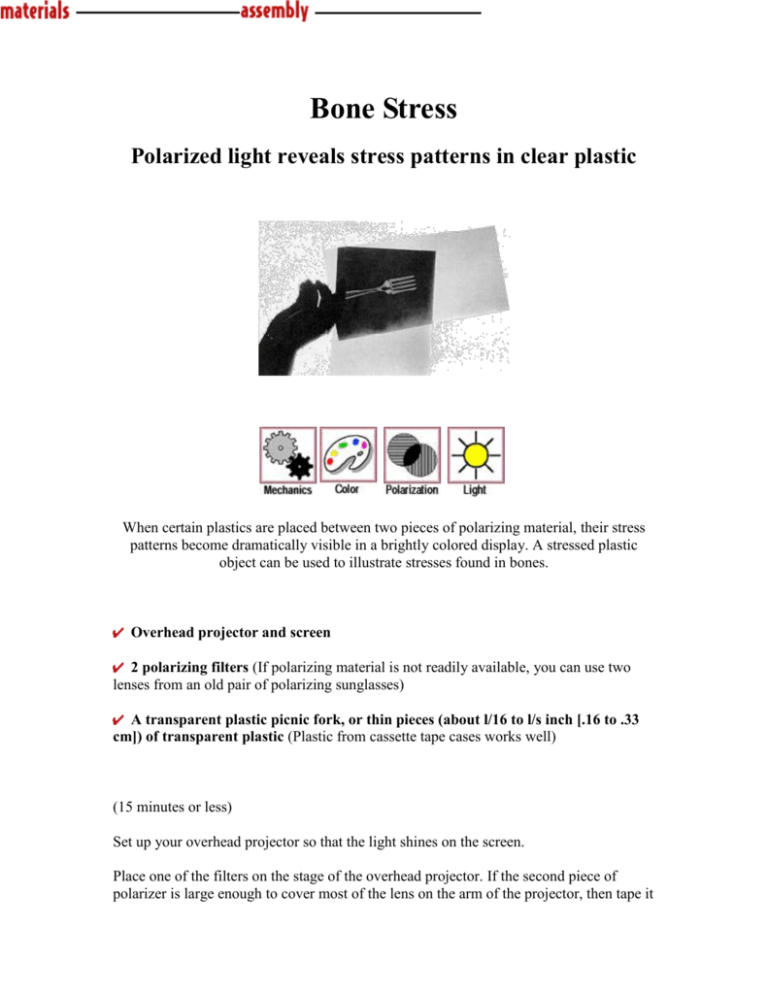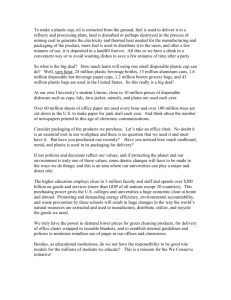Bone Stress (polarized ligth inteference)
advertisement

Bone Stress Polarized light reveals stress patterns in clear plastic When certain plastics are placed between two pieces of polarizing material, their stress patterns become dramatically visible in a brightly colored display. A stressed plastic object can be used to illustrate stresses found in bones. Overhead projector and screen 2 polarizing filters (If polarizing material is not readily available, you can use two lenses from an old pair of polarizing sunglasses) A transparent plastic picnic fork, or thin pieces (about l/16 to l/s inch [.16 to .33 cm]) of transparent plastic (Plastic from cassette tape cases works well) (15 minutes or less) Set up your overhead projector so that the light shines on the screen. Place one of the filters on the stage of the overhead projector. If the second piece of polarizer is large enough to cover most of the lens on the arm of the projector, then tape it there. (See drawing.) If you are using the lens from a pair of sunglasses, then devise a stand to hold the lens a few inches above the stage of the projector, right over the first filter. If you are using thin plastic, such as the plastic from a cassette tape case, cut it into the shape of letters that can be flexed (C, J, S, K, etc., or any other shape that can be flexed). (5 minutes or more) Hold the fork or plastic letter above the first filter and below the second filter. Induce stress by squeezing the tines of the fork together or deforming the letter. Notice the colored stress pattern in the image of the plastic that is projected on the screen. Try rotating one of the polarizing filters. Some orientations will give more dramatic color effects than others. The first polarizing filter limits the vibration of light waves to one plane --- that is, it polarizes the light. The white light of the overhead projector is made up of light of all colors. The plastic breaks the light waves that make up each color into two perpendicularly polarized waves. These two waves travel through the plastic at different speeds, which are determined by the light's color. When the two waves meet and recombine, they produce a polarization unique to that color. The direction of polarization determines whether light of a certain color can pass through the second polarizing filter. If the new direction of polarization lines up with the second filter, light of that color passes through the filter and you see it. If the new direction of polarization does not line up with the second filter, light of that color is blocked. By rotating the filter, you can let different colors pass through, and the colors you observe will change. Stressing the plastic alters its structure, which affects how rapidly light of different polarizations travels through the plastic. Where colored patterns change rapidly, stress is high. Where colored regions are spread out and change gradually, stress is low. Sharp corners, or areas that have been cut or stamped, are usually areas of stress concentration. Changing the stresses in the plastic will change the color pattern in the plastic. Stress patterns and concentrations like the ones visible in the plastic are also present in your bones, as they flex under the daily loads imposed upon them. The college editions of Conceptual Physics by Paul Hewitt (HarperCollins College Publishers, New York, 1993) contain an excellent diagram and explanation of the formation of colors by polarized light traveling through plastic or similar material. You will need to have a basic understanding of vectors to read this material. For related information, see the PolarizedLight Mosaic Snack.







